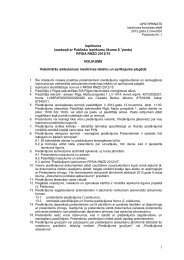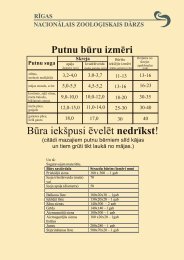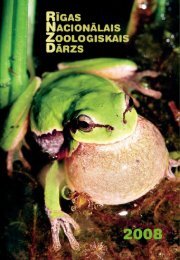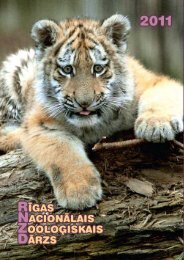Create successful ePaper yourself
Turn your PDF publications into a flip-book with our unique Google optimized e-Paper software.
Animal collection<br />
At the end of 2009, there were 405 animal species with 3542 specimens in Riga Zoo. 119 species bred,<br />
1688 young in total were born or hatched in 2009. Comparing with the previous year, the number of species<br />
had decreased, bur owing to good animal breeding results and successful chytrid infection control within<br />
Amphibian Department, the total animal numbers of the zoo had increased by 31%.<br />
During the year, 750 specimens of 61 species were sent to 42 zoos and animal collections within 17<br />
countries. 23 new species were added to the animal collection. Among them were Partula suturalis strigosa,<br />
a mollusc species extinct in the wild, Dholes Cuon alpinus lepturus, a pair of Secretary Birds Sagittarius<br />
serpentarius from Tanzania, etc.<br />
Invertebrates<br />
At the end of 2009, there were 62 invertebrate species in Riga Zoo’s collection. 44 species bred in 2009.<br />
In spring we received one of the heaviest phasmid species, Heteropteryx dilatata, from Latgale Zoo,<br />
Daugavpils, and already introduced those insects to the terrestrial invertebrate exhibit in Tropical House.<br />
In collaboration with private breeders we received three new cockroach species as well, Lucihormetica<br />
verrucosa, Therea petiveriana and T. olegrandjeani. Flower beetle Eudicella smithii larvae and locusts<br />
Tropidacris violaceus were sent to Nordens Ark.<br />
The population of Fregate Island Palm Beetles Polposipus herculeanus (EEP) increased. Beetles and larvae<br />
were sent to Zoological Society to London for renewal of their Polposipus population. The beetles of the 2nd<br />
generation are exhibited in Tropical House, but the 3rd and 4th generation is kept in Insectarium off-exhibit<br />
premises and bred. In 2009 the 5th generation of beetles emerged, and towards the end of the year – the<br />
larvae of 6th generation started to erupt as well.<br />
Within Partula EEP, we continue to work with P. varia and P. tristis, and since this year – with P. suturalis<br />
strigosa as well. Interesting addition to snail collection of Amphibian Department was Rosy Wolf Snails<br />
Euglandina rosea, received from Tahiti this July.<br />
Insectarium Department continued the food insect production. Other zoo animal departments were<br />
supplied by 99.8 kg of locusts, crickets and other live food insects.<br />
Fish<br />
At the end of 2009, there were 60 species in Riga Zoo’s fish collection. Nine species bred. Those included<br />
Suckermouth Catfishes Hemiancistrus dolichopterus, Madagascar Rainbowfishes Bedotia geayi, Red<br />
Rainbowfishes Glossolepis incisus, Banded Rainbowfishes Melanotaenia trifasciata, Chipokee Mbuna Cichlids<br />
Melanochromis chipokae, Cobalt Blue Zebra Cichlids Pseudotropheus zebra, etc.<br />
Amphibians<br />
At the end of 2009, there were 49 species of amphibians in Riga Zoo’s collection. 23 species bred.<br />
Good results were attained in breeding of Latvian amphibians (Riga Zoo holds all native amphibian<br />
and reptile species). We raised European Fire-bellied Toad Bombina bombina young in the 1st and 2nd<br />
generation. Natterjack Toads Bufo calamita were bred for the third time, more than 100 young are growing<br />
(the two previous successful breedings took place in 2003 and 2007). The initial breeding stock was collected<br />
from the wild in Bēne in 1996 and is living in captivity already for more than ten years, so it was important<br />
to breed the species to maintain it in the exhibit. Natterjack Toad is a threatened species in all Europe, and<br />
breeding techniques of Bufo species are still to be developed.<br />
Of exotic amphibian species, a good achievement was breeding of Tropical Clawed Frogs Silurana<br />
tropicalis. Unlike common Xenopus species, breeding of Tropical Clawed Frogs in captivity is more difficult<br />
as tadpoles feed via filtering of water versus nibbling of food chunks. Due to this, tadpoles have to be fed<br />
several times a day with small portions of various foods dispersed into water.<br />
Several new species were added to the amphibian collection via animal exchange. Such additions<br />
included Reinwardt’s Flying Frogs Rhacophorus reinwardtii, Chapa Bug-eyed Frogs Theloderma bicolor, and<br />
Emperor Newts Tylototriton shanjing.<br />
Special attention was paid to animal quarantining and medical treatment. The prevention of<br />
Batrachochytrium dendrobatidis (chytrid fungus) infection and other diseases was a priority, as chytrid<br />
infection had caused considerable losses in our amphibian collection during previous years. During<br />
21








